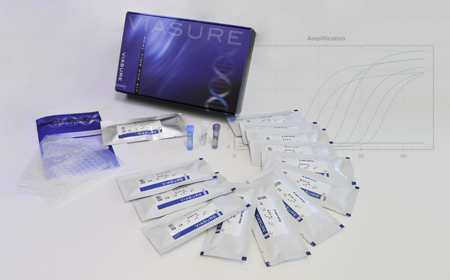
VIASURE Real Time PCR Detection Kits
Crimean-Congo Haemorrhagic Fever

Description
VIASURE Crimean-Congo hemorrhagic Fever Virus Real Time PCR Detection Kit is designed for detection of Crimean-Congo hemorrhagic Fever Virus in serum, blood, and/or body fluids collected from patients with signs and symptoms of Crimean-Congo hemorrhagic Fever Virus infection.
This test is intended for use as an aid in the diagnosis of the Crimean-Congo hemorrhagic Fever Virus in combination with clinical and epidemiological risk factors.
RNA is extracted from specimens, amplified using RT-PCR and detected using fluorescent reporter dye probes specific for Crimean-Congo hemorrhagic Fever Virus.
Specifications
Information
Crimean-Congo hemorrhagic fever (CCHF) is caused by infection with a tick-borne virus (Nairovirus) in the family Bunyaviridae. The disease was first characterized in the Crimea in 1944 and given the name Crimean hemorrhagic fever. It was then later recognized in 1969 as the cause of illness in the Congo, thus resulting in the current name of the disease.
The Crimean-Congo haemorrhagic fever (CCHF) virus causes severe viral haemorrhagic fever outbreaks. The length of the incubation period depends on the mode of acquisition of the virus. Onset of symptoms is sudden, with fever, myalgia, dizziness, neck pain and stiffness, backache, headache, sore eyes and photophobia. There may be nausea, vomiting, diarrhoea, abdominal pain and sore throat early on, followed by sharp mood swings and confusion. After two to four days, the agitation may be replaced by sleepiness, depression and lassitude, and the abdominal pain may localize to the upper right quadrant, with detectable hepatomegaly. Other clinical signs include tachycardia, lymphadenopathy, and a petechial rash on internal mucosal surfaces, such as in the mouth and throat, and on the skin. The petechiae may give way to larger rashes called ecchymoses, and other haemorrhagic phenomena. There is usually evidence of hepatitis, and severely ill patients may experience rapid kidney deterioration, sudden liver failure or pulmonary failure after the fifth day of illness.
The virus is primarily transmitted to people from ticks of the genus Hyalomma (are the principal vector) and livestock animals. Human-to-human transmission can occur resulting from close contact with the blood, secretions, organs or other bodily fluids of infected person.
Tests on patient samples present an extreme biohazard risk and should only be conducted under maximum biological containment conditions. However, if samples have been inactivated (e.g. with virucides, gamma rays, formaldehyde, heat, etc.), they can be manipulated in a basic biosafety environment.
Laboratory tests that are used to diagnose CCHF include ELISA, real time PCR, virus isolation cell by culture, and detection of antibody by ELISA (IgG and IgM). The CCHFV genome can be detected with RT-PCR from serum, blood, and tissue autopsy. Real Time RT-PCR is a detection method commonly used during the acute phase of the infection.
